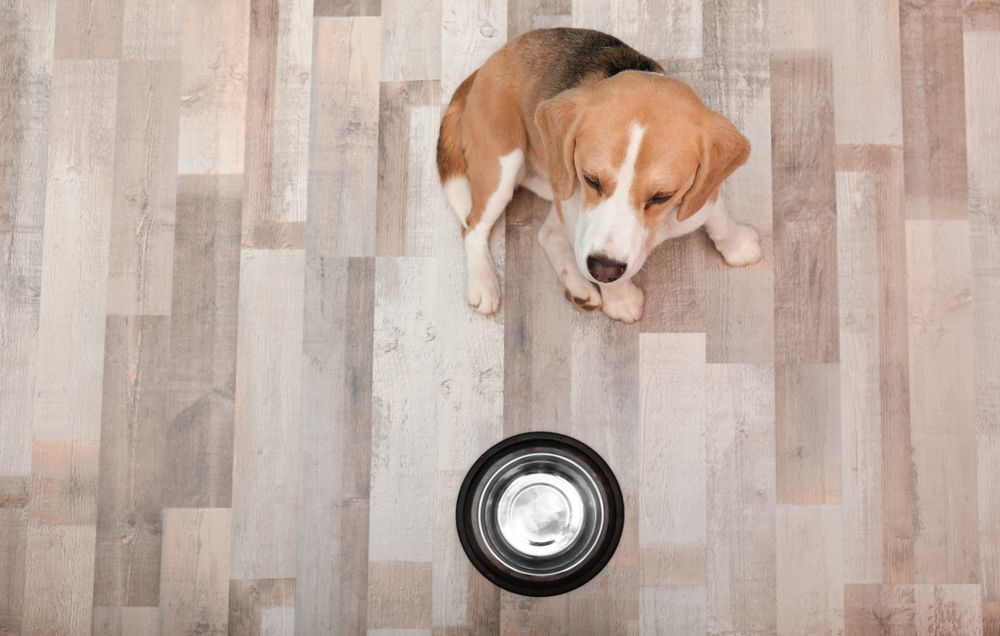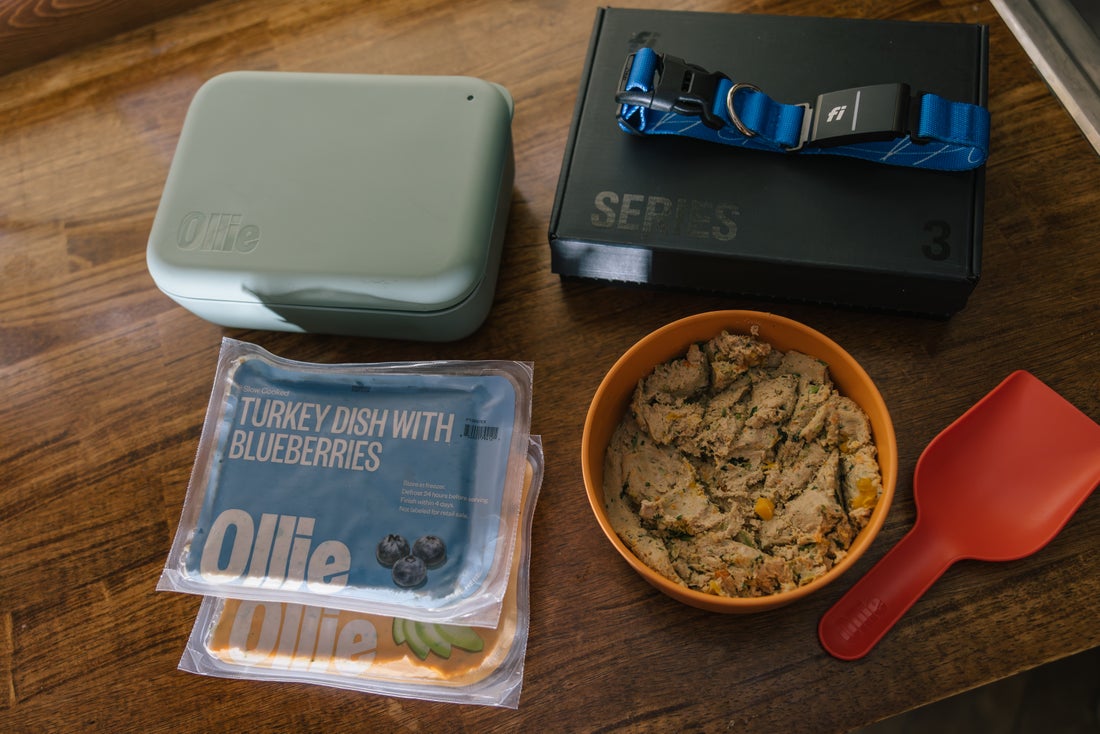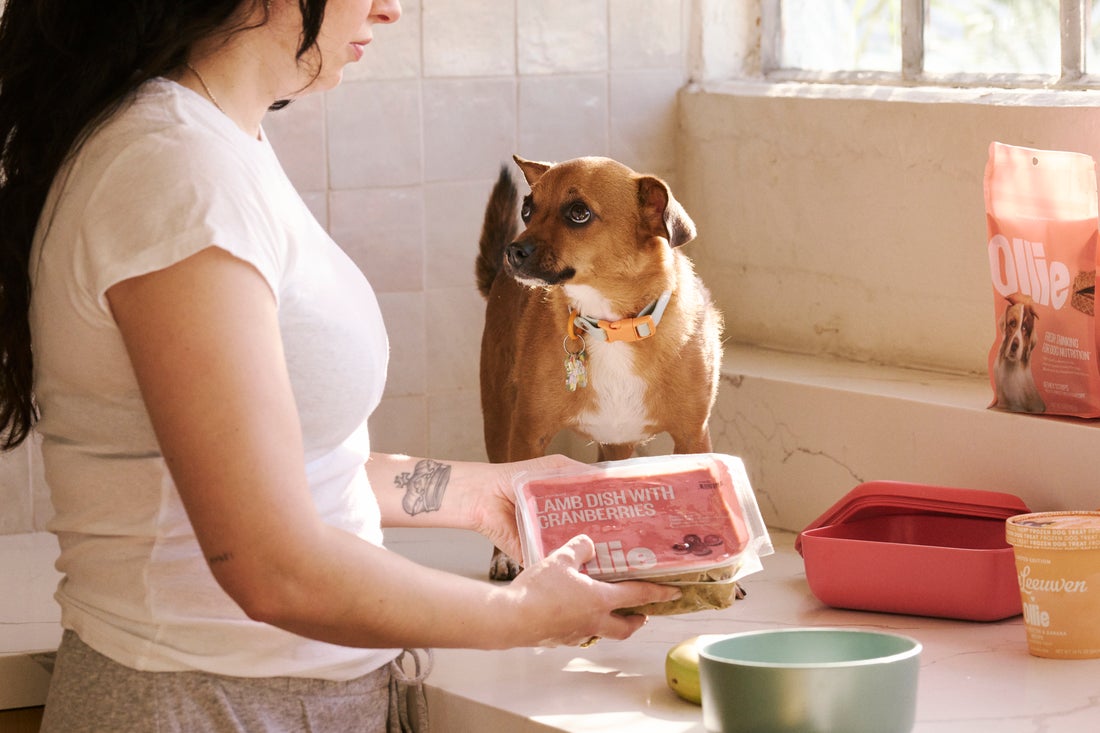Hey Ollie blog readers! We’re offering you an exclusive 60% OFF your starter box! Try now!
Feeding a puppy isn’t just about keeping their belly full—it’s about fueling steady growth, proper development, and a healthy future. From chubby-cheeked eight-week-olds to lanky adolescents, every stage of puppyhood has unique nutritional needs.
But how much should you feed a puppy? The answer depends on a few key factors: your pup’s age, breed, weight, and energy level. Too much food can lead to excess weight and joint strain. Too little can slow development or trigger low blood sugar, especially in small breeds.
In this guide, we’ll break down:
- How much to feed your puppy by age and size
- How often puppies should eat each day
- Portion sizes for different breeds and weights
- Feeding tips for healthy digestion and weight management
Whether you’re preparing your puppy’s first bowl or adjusting their meal plan as they grow, this guide will help you feed with confidence.
How Much to Feed a Puppy During Their First Year
Puppies grow fast—and their nutritional needs change just as quickly. What you feed them (and how much) in their first year sets the foundation for a healthy, strong adult dog. Proper portion sizes ensure your pup gets the right balance of calories, protein, fat, and essential nutrients to fuel everything from muscle growth to brain development.
But how much food should you actually be scooping into their bowl? It depends on your puppy’s age, breed size, and estimated adult weight.
Below is a helpful guide to average feeding amounts based on your puppy’s expected adult size and their current age.
Puppy Feeding Chart: Weight & Age
| Estimated Adult Weight | 1.5–3 months | 4–5 months | 6–8 months | 9–11 months | 1–2 years |
| 3–12 lb | ½ – 1 cup | ⅔ – 1⅓ cups | ½ – 1½ cups | Feed as adult | Feed as adult |
| 13–20 lb | ½ – 1¼ cups | 1⅛ – 2 cups | ¾ – 1⅓ cups | ½ – 1½ cups | Feed as adult |
| 21–50 lb | ½ – 1½ cups | 1½ – 2¾ cups | 1⅛ – 2⅔ cups | 2 – 3 cups | 2 – 4¼ cups |
| 51–75 lb | ⅝ – 2⅔ cups | 1½ – 4 cups | 1½ – 3¾ cups | 2½ – 4¾ cups | 2½ – 6¼ cups |
| 76–100 lb | 1 – 2⅔ cups | 2⅞ – 3¾ cups | 2⅞ – 6⅓ cups | 3⅞ – 7 cups | 5½ – 11 cups |
| 101+ lb | 2⅔ cups + ⅓ cup for every 10 lb over 100 lb | 3¾ cups + ⅓ cup/10 lb | 6⅓ cups + ⅓ cup/10 lb | 7 cups + ⅓ cup/10 lb | 11 cups + ⅓ cup/10 lb |
Note: These amounts are general estimates and assume high-quality puppy food with balanced nutrition. Your puppy’s needs may vary based on breed, metabolism, and activity level.

Puppy Feeding Stages Timeline
Just like human babies, puppies go through several developmental stages that affect how—and what—they should eat. From milk-only newborns to fully weaned, active pups, their feeding needs evolve quickly during the first year. Below, we break down the key feeding milestones by age to help you support your puppy’s growth every step of the way.
Stage 1: 8-12 weeks of age
Ideally, puppies stay with their mother until they are at least 8–10 weeks of age, as this is a critical period when they learn key social skills. During this stage, puppies need specially formulated food to fuel their rapid growth and development. If you have a large breed puppy, ensure their food is formulated for large breed dogs. This is essential for ensuring controlled and steady growth and can reduce your puppy’s risk for potential hip, elbow, or knee problems.
At this age, puppies should be eating three to four small meals per day. Regular feeding supports your puppy’s quick metabolism and helps them maintain appropriate energy levels for learning and play. Consider this suggested feeding schedule for a puppy who is 8–12 weeks of age:
Sample feeding schedule
|
Time of Day |
Action |
|
6:00 AM |
Wake up and go to the bathroom. |
|
6:30 AM |
Breakfast #1 |
|
7:30 AM | Explore the yard or play with toys. Regular potty breaks, especially after eating, playing, or waking from a nap, roughly every 30–45 minutes when your puppy is awake. Puppies should take a lot of naps throughout the day. |
|
9:30 AM | Breakfast #2—This meal can be used as a reward after training session #1. |
| Noon | Lunch |
|
4:00 PM | Training session #2 (5–10 minutes) |
|
5:00 PM | Dinner |
|
6:00 PM | Snack while pet parents eat dinner. Afterward, a potty break and play. One final play session will promote healthy rest at bedtime. |
Stage 2: 3-6 months of age
When your puppy is around 3 months of age, you may be able to reduce their meal frequency. Although this might come as a disappointment to a food-loving pup, cutting back on your puppy’s meal frequency will simplify your daily schedule and, more importantly, your puppy’s potty training. Always follow your veterinarian’s guidance to ensure you are providing your puppy with adequate nutrition at the correct intervals.
If you do reduce your pup’s meal schedule, consider having them eat when you do (e.g., breakfast, lunch, dinner). Your puppy is still rapidly growing at this stage, so you may need to adjust their daily calorie intake frequently. Ask your veterinarian to demonstrate how to assess your puppy’s body condition and review your feeding plan to ensure you are meeting your growing puppy’s ever-changing nutritional needs.
Raising a Puppy: The Ultimate Guide
Stage 3: 6-12 months of age
Depending on your puppy’s breed or estimated adult size, their growth rate may begin to slow between 6 and 12 months of age. If this is true for your puppy, you should be able to decrease their feedings to two meals per day. Doing so will help avoid undesirable weight gain, which will put an unnecessary strain on your puppy’s juvenile joints and predispose them to orthopedic injuries.
Some debate exists regarding how early pet parents should switch their puppies from a puppy-specific formula to adult food. Consult your vet about the best time to make the switch for your dog. Veterinarians generally believe that feeding puppy food for a longer period is healthier than prematurely switching to adult dog food. However, we do recommend researching adult dog food brands and formulas at this point during your puppy’s growth so that you are fully prepared to make the gradual transition as soon as your vet determines your puppy is ready. If you’ll be making the leap from a kibble-based diet to a fresh highly digestible whole food diet, such as Ollie, allocate at least one week to making the switch. With so many brands on the market, free resources, such as the Dog Food Advisor and the Association of American Feed Control Officials (AAFCO), can help you make an informed decision about your pup’s food.
Stage 4: After 1 year of age
Although your puppy may look like an adult, many 12-month-old dogs still have a lot of growing to do. Large and giant breed dogs physically mature at a slower pace than breeds of other sizes, and they may not fully mature until they are 2 years of age. In addition, despite their adult bodies, large and giant breed dogs may still think and behave as though they are puppies.
Talk to your dog’s breeder or veterinarian to ensure you continue to meet your pup’s individual nutritional needs, including an adequate food portion size and formulation. Although a small- or medium-sized dog can be fed an adult diet, a large or giant breed dog needs additional time and support to reach sexual and social maturity.
How Much to Feed a Puppy at Each Meal
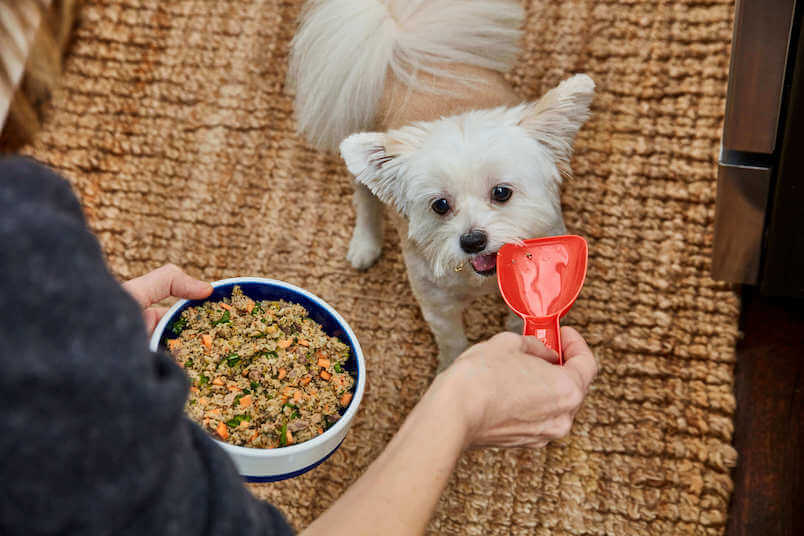
In addition to their unique individual characteristics and conformation, puppies change so much and so rapidly that definitively determining how much to feed a puppy is impossible. Before deciding a food amount that is adequate to feed your puppy, consider the following factors regarding your pup such as:
- Age
- Breed
- Size
- Activity level
- Health (e.g., are they recovering from parasitic worms or previous malnutrition?)
- Food type and caloric content
The simplest way to determine how much to feed your puppy at each meal is to calculate their daily portion based on their expected adult weight. For example, let’s say you’re feeding your puppy a kibble-based formula, and the package guidelines recommend two cups per day for your puppy’s age (e.g., 4 months) and current size (e.g., 18 pounds). If your puppy is extremely active, you may need to increase their daily portion to 2 1/4 cups per day. Divide this total portion across your puppy’s daily meals. If you feed three meals per day, you’ll need to feed your puppy ¾ cup of kibble at each meal. Reassess your pup’s body condition after a few days to determine whether they need additional calories.
We recommend using the Waltham Growth Chart as a tool to estimate your pup’s adult weight based on their breed and current size. You can select a pre-made chart based on their weight, or use their tool to input data as your pup grows. Here are two examples:
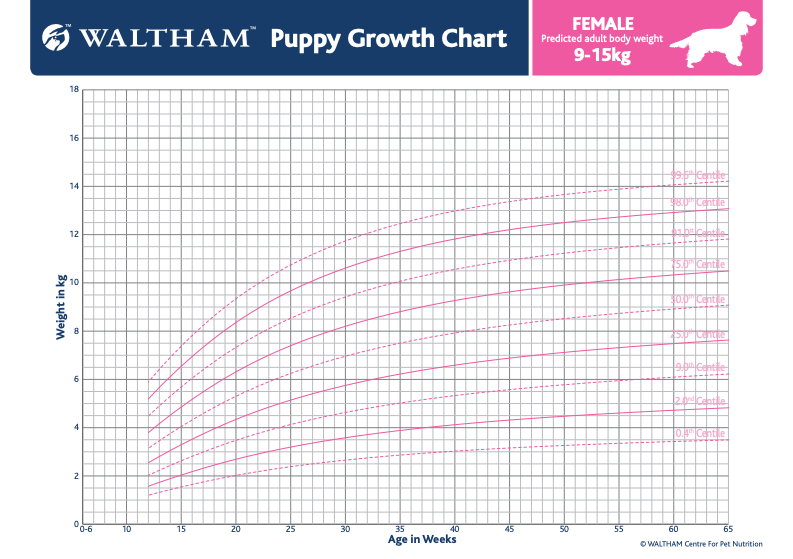
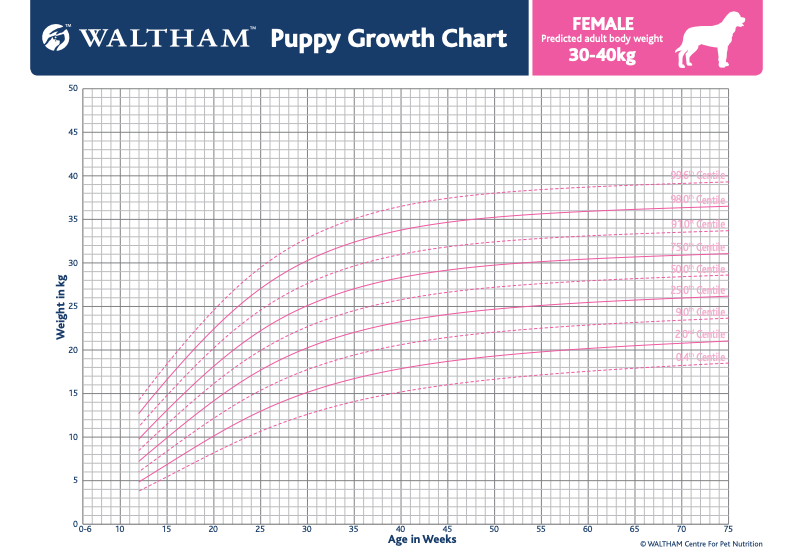
At Ollie, we want to ensure your puppy thrives today and always. We offer five nutritious fresh food recipes that are highly digestible and great for developing digestive tracts. Our recipes also provide complete and balanced nutrition full of the essential nutrients your puppy needs. In addition, puppies love our gently cooked human-grade proteins—chicken, turkey, beef, pork, and lamb. You’ll feel a sense of satisfaction when you watch your puppy enjoying their Ollie food, and you’ll appreciate how each meal promotes your pup’s healthy and consistent eating habits, which leave no room for frustrating finicky behavior.
As a new puppy owner you have a lot of concerns, but when you feed your pup Ollie meals, you can feel confident that they’re receiving fresh and precise nutrition at each stage of their growth journey. When you sign up your puppy for an Ollie meal plan, we’ll ask you about their age, breed, weight and activity level, so we can design a personalized meal plan, including precisely measured portions, that meets their needs.
When your pup’s food arrives at your door, simply unpack the freshly frozen and individually wrapped packages and store them in your refrigerator or freezer. As your puppy grows, simply provide us with updated information, and we’ll adjust their serving sizes accordingly. No more weighing, measuring, or guesswork required—just simple, healthy, whole food nutrition.
Pro Tips for Feeding a Puppy
Set a routine
Puppies thrive on predictability. Having a consistent feeding and exercise routine will help your puppy feel safe and confident, and expedite potty training.
Gradually transition food
In addition to your puppy’s eventual transition to adult food, other circumstances may necessitate a switch, such as if your puppy is a picky eater, or if your vet suspects your pup is suffering from a food sensitivity (e.g., experiencing regular vomiting, loose stools, or low energy). However, you shouldn’t totally and immediately switch your pup’s food. Puppies have highly sensitive stomachs, and an abrupt diet change can lead to digestive upset. Plan to gradually transition over 7–10 days, or as your vet advises.
Count training treats as part of your puppy’s calorie intake
High-value treats can accelerate your puppy’s training by reinforcing correct behaviors and increasing the likelihood that they will repeat them in the future. However, no matter which treat your puppy prefers, they all have one thing in common—calories.
15 Easy Homemade Dog Treat Recipes
Because you’ll be frequently rewarding your puppy for all the good things they do, those extra calories really add up quickly and can lead to undesirable weight gain. Fortunately, your puppy can have their treats and eat them too, when you adjust their food portions on days when you train for longer periods (e.g., class days, social outings). Consider feeding your pup low-calorie treats, cutting large-size treats into bite-size portions, or using your puppy’s food as their training rewards and practice behaviors during mealtime.
Find a puppy-specific formula
Puppies have critical nutritional needs that adult formula dog foods usually don’t include, so you should ensure your puppy’s food is labeled for their life stage, or meets the AAFCO requirements for growth or all life stages. If your puppy is a large breed, pay careful attention to the AAFCO statement to determine whether the formulation of the food you plan to feed your pup is adequate for your puppy’s size (i.e., more than 70 pounds).
According to the American Kennel Club, “A dog born weighing one pound can grow to 150 pounds within the first 18 months of its life. This accelerated growth rate means that large breed puppies are very sensitive to nutrient and caloric intake—imbalances, deficiencies, and excesses all negatively impact your large breed puppy’s health. Growing too quickly is not healthy for large breed puppies. Excessive growth has been linked to developmental orthopedic disease (DOD).”
At Ollie, we prioritize your pup’s health right from the start by offering five complete and balanced veterinary nutritionist-designed recipes and customized meal plans. Each portion is perfectly calculated and packaged for your pup’s unique needs.
Consider giving your puppy a puzzle or slow feeder
Rapid eating can cause indigestion, vomiting, flatulence, or in more serious cases, bloat. Help your puppy slow down at mealtime by using a puzzle feeder or an interactive feeding method. Doing so makes your dog work to access their food. In addition to improving your puppy’s digestion and post-meal comfort, these toys also provide fun mental enrichment.
While these tips are helpful general guidelines, we recommend you consult your puppy’s veterinarian or breeder to determine their best nutrition plan. They can also recommend an appropriate meal schedule and food formulation to fuel your one-of-a-kind pup’s body and mind.
Benefits of a Fresh Food Diet for Puppies
Ollie’s vet-approved recipes contain all the ingredients your puppy needs for their health and wellness. Unlike kibble puppy foods, our fresh food recipes are gently cooked to preserve nutrients, moisture, and of course, flavor. Fresh foods’ benefits for puppies are innumerable, but we present the most important ones here:
- Fewer ingredients — Fewer ingredients mean better digestion for your puppy and peace of mind for you.
- Minimal processing — Our foods retain their nutritional value, because we gently cook them, never using high heat.
- No fillers or artificial ingredients — Fillers, such as corn, wheat, and soy, can trigger allergic reactions. In addition, these fillers have little to no nutritional benefit.
- Easy digestibility — Our recipes include turkey and lamb options for puppies with sensitive stomachs. We recommend feeding your puppy these proteins first when transitioning to a fresh food diet.
- Immune-boosting antioxidants — Antioxidant-rich ingredients, such as blueberries, spinach, and kale, support your puppy’s developing immune system.
- Omega-3 fatty acids — Fish oil contains docosahexaenoic acid (DHA) and eicosapentaenoic acid (EPA) for healthy brain development.
Best of all, because Ollie recipes are complete and balanced for all life stages, you won’t have to worry about switching your puppy to an adult dog food. However, for nutritional variety and excitement, consider rotating the proteins you feed your dog.


Healthier ingredients,
tailored recipes, delivered
Get 50% of your first box of Ollie’s fresh
delivered meals today!
The Ollie blog is devoted to helping pet parents lead healthier lives with their pups. If you want to learn more about our fresh, human-grade food, check out MyOllie.com.
Tagged As:

The nutrition your dog needs,
the food they want.

Enjoying our articles? Subscribe our Newsletters and get new articles directly to your inbox
You might also like
18 September 2025
5 MINS READ
Can I Rotate Fresh Dog Food Flavors?
Yes, it’s safe to rotate fresh dog food flavors, and many dogs actually benefit from the variety. At Ollie, we offer multiple fresh recipes, like Beef, Chicken, Turkey, Lamb, and Pork so you can…
by Ollie Pets
18 September 2025
5 MINS READ
Is Fresh Dog Food Safe During Power Outages?
Fresh dog food is only safe during a power outage if it has stayed cold, specifically, below 40°F. Once the temperature rises above that point, bacteria can start to grow, and the food may no lon…
by Ollie Pets
18 September 2025
5 MINS READ
How Do I Store Fresh Dog Food While Traveling?
If you’re bringing fresh dog food on the road, keeping it cold is key. The best way to store it is in a cooler with ice packs or a travel freezer. At Ollie, our vacuum-sealed fresh food stays good…
by Ollie Pets
